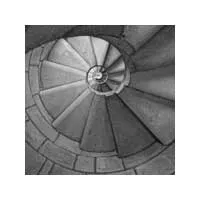Content
- Warm Neutrals for a Cozy Vibe
- Bold Blues for a Modern Touch
- Classic Whites for a Timeless Look
- Earthy Greens for a Natural Feel
- Vibrant Yellows for a Cheerful Appearance
- FAQ
- How can I use warm neutrals to create a cozy exterior without my home looking too plain?
- What are the best architectural styles for a bold blue exterior, and how should I choose the right shade?
- Is a classic white exterior always the best choice for improving a home's perceived value?
Choosing the right color scheme for your home’s exterior can be a daunting task. The colors you choose will define your home’s appearance and can even affect its perceived value. With the rise in popularity of different design trends, it’s important to choose a color scheme that is not only aesthetically pleasing but also timeless. In this article, we will explore some inspiring exterior house color schemes that will transform your home and enhance its curb appeal.
Warm Neutrals for a Cozy Vibe
The exterior of your home is the first thing people see when they approach your property. It sets the tone for the rest of your home and can greatly affect your home’s curb appeal. One of the most important decisions you will make when it comes to your home’s exterior is the color scheme. The right exterior house color schemes can transform your home from ordinary to extraordinary. One popular choice for many homeowners is warm neutrals. Warm neutrals, such as beige, tan, and light brown, create a cozy and inviting atmosphere that is perfect for any home.
Warm neutrals are versatile and timeless. They work well with a variety of architectural styles and can be easily complemented with other colors and materials. For example, warm neutrals pair beautifully with natural materials, such as stone or wood, and can be accented with bolder colors, such as navy blue or forest green, for a pop of color. Additionally, warm neutrals work well in a variety of settings, from urban to rural, and can be adapted to suit your home’s surroundings.


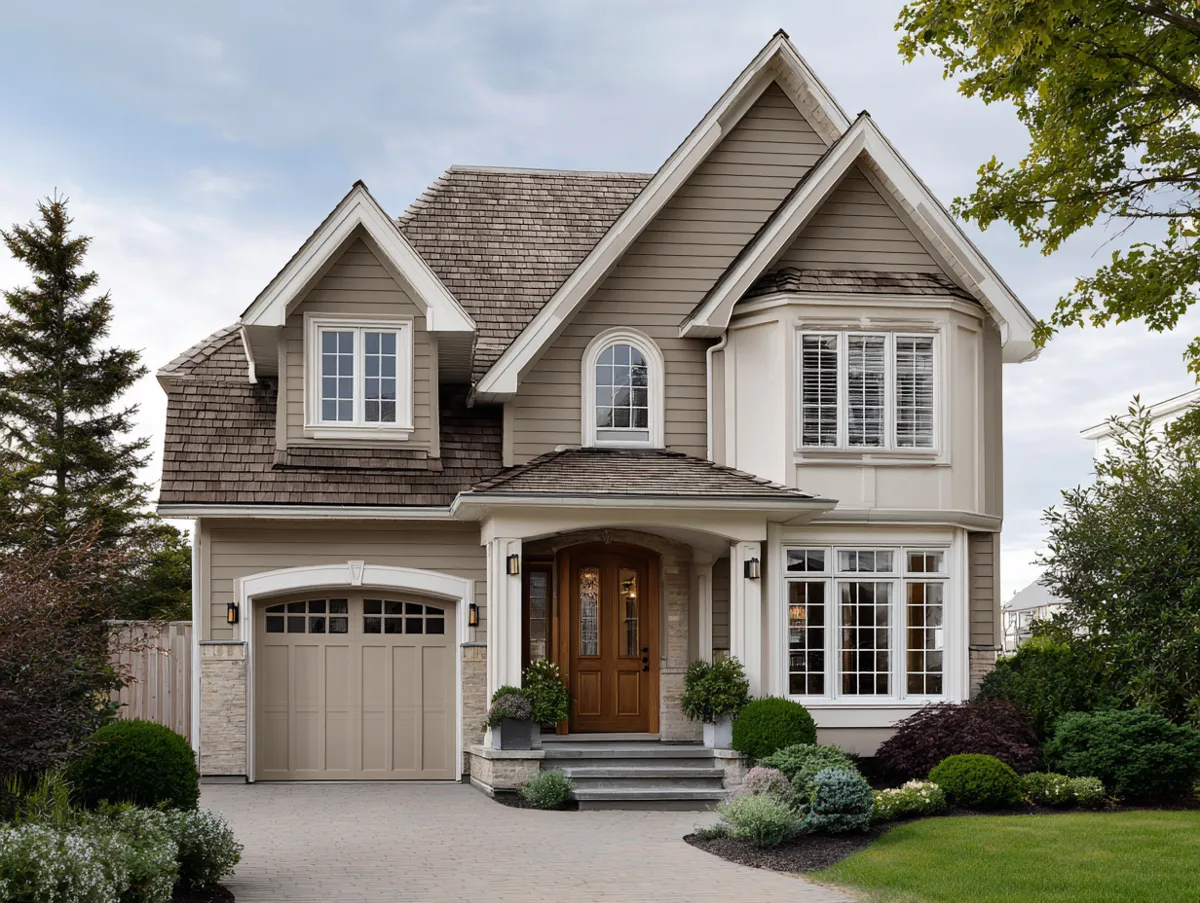



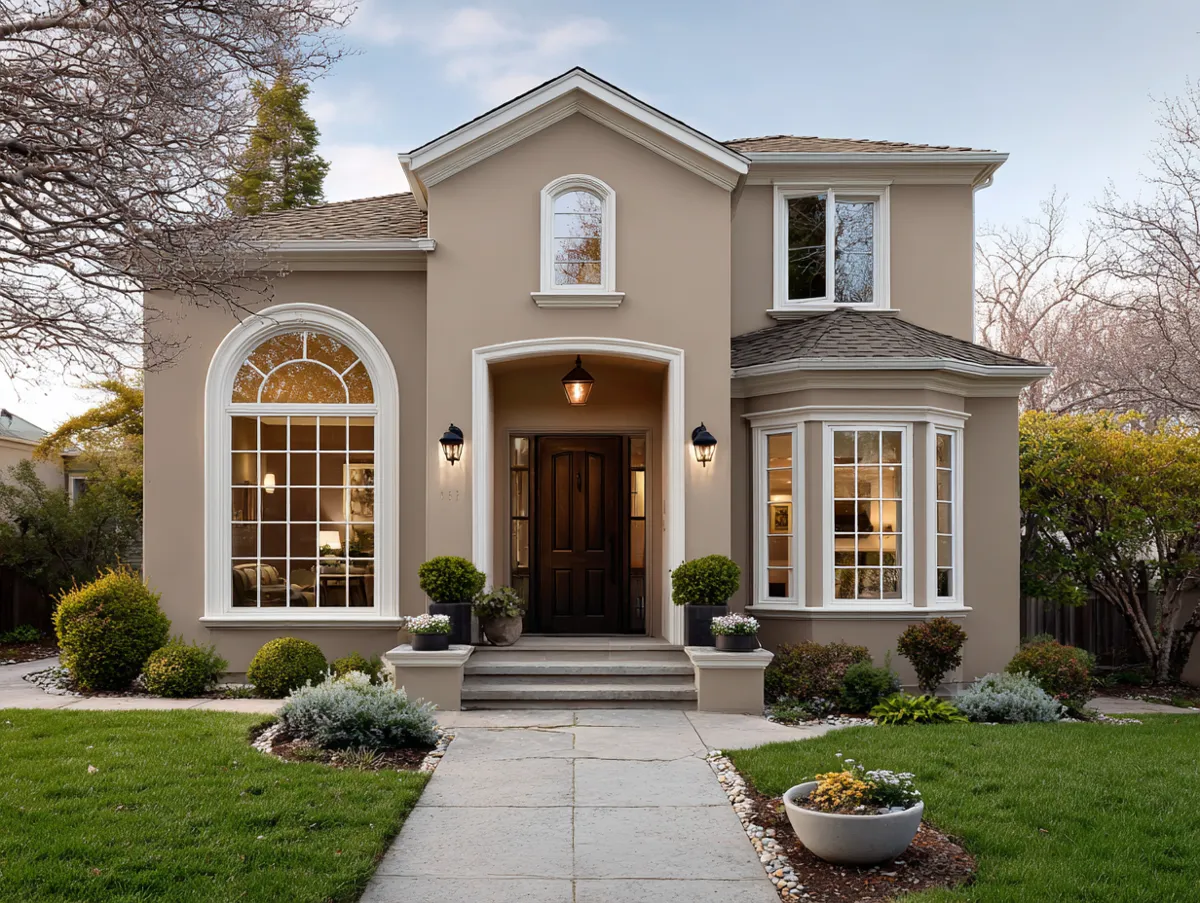



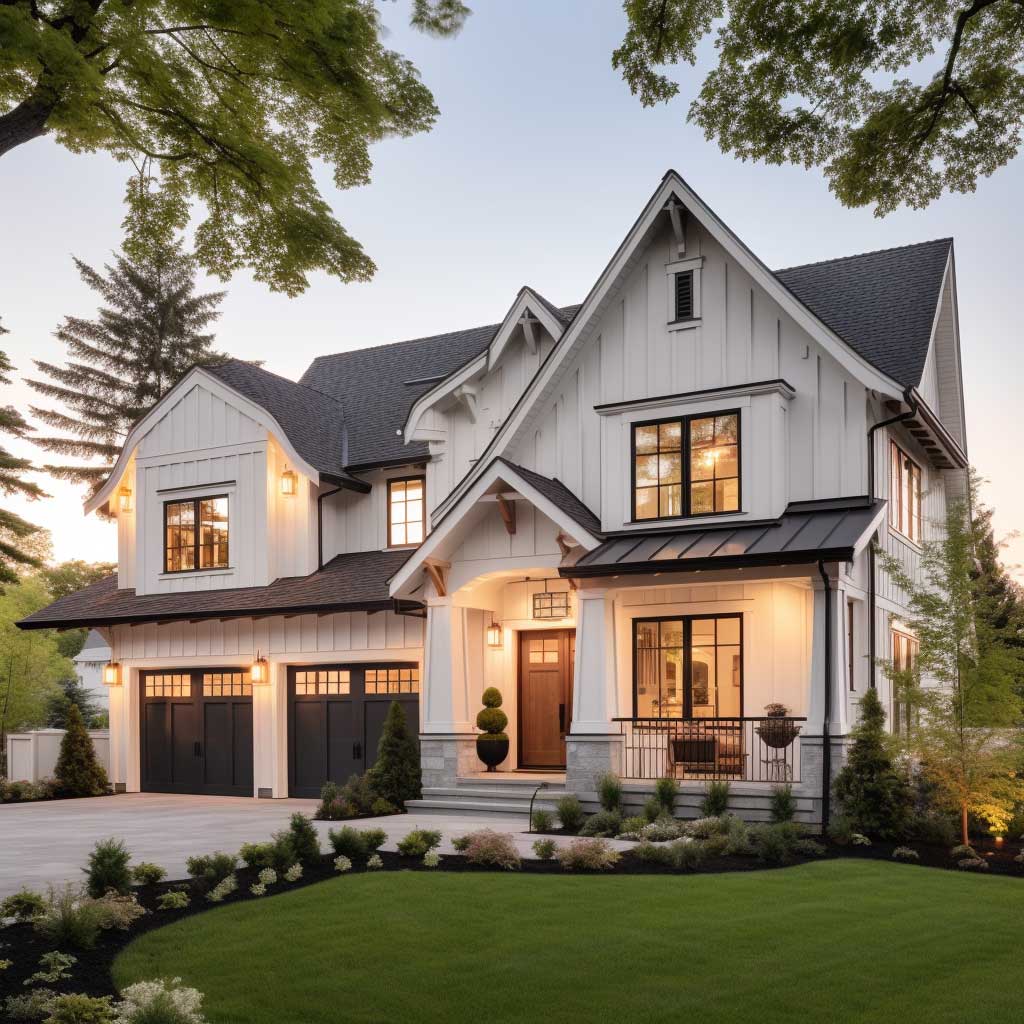





When choosing a warm neutral color scheme for your home’s exterior, there are a few things to consider. First, consider the architecture of your home. Certain architectural styles, such as Craftsman or Mediterranean, lend themselves well to warm neutrals. The natural materials and detailed craftsmanship of these styles are complemented by the understated elegance of warm neutrals.
Next, consider your home’s surroundings. If your home is set in a natural landscape with lots of trees and greenery, a warm neutral color scheme can help your home blend seamlessly with its surroundings. On the other hand, if your home is in an urban setting with lots of man-made materials, a warm neutral color scheme can add a touch of warmth and coziness to your home’s exterior.
Another important consideration when choosing a warm neutral color scheme is the amount of sunlight your home receives. Warm neutrals tend to look best in natural light, so if your home receives a lot of sunlight, a warm neutral color scheme may be a good choice. However, if your home is in a shaded area or does not receive a lot of natural light, you may want to consider a different color scheme.
When it comes to choosing the specific colors for your warm neutral color scheme, there are a few options to consider. One option is to choose a monochromatic color scheme, which uses varying shades of the same color. For example, you could choose a light beige for the main color of your home, a darker beige for the trim, and a tan color for the accents. This creates a cohesive and harmonious look.
Another option is to choose a complementary color scheme, which uses colors that are opposite each other on the color wheel. For example, you could choose a beige color for the main color of your home, a brown color for the trim, and a terracotta color for the accents. This creates a balanced and harmonious look.
Finally, consider the finish of the paint. A flat or matte finish will give your home a more understated and sophisticated look, while a glossy finish will add a touch of shine and glamour.
In summary, warm neutrals are a versatile and timeless choice for exterior house color schemes. They create a cozy and inviting atmosphere and can be easily complemented with other colors and materials. When choosing a warm neutral color scheme for your home’s exterior, consider your home’s architecture, surroundings, and the amount of sunlight it receives. Additionally, consider whether a monochromatic or complementary color scheme will work best for your home, and choose the finish of the paint accordingly.
Bold Blues for a Modern Touch
The color of your home’s exterior plays a crucial role in determining its overall aesthetic appeal. While neutral tones are timeless and classic, bold colors can make a strong statement and give your home a modern and contemporary feel. One such bold color that has been gaining popularity in recent years is blue. Blue, in its various shades, can create a striking and dynamic exterior house color scheme that stands out in any neighborhood.
Blue is a versatile color that can be adapted to suit a variety of architectural styles and settings. From a bright and vibrant turquoise to a deep and moody navy, there is a shade of blue that will work for any home. Additionally, blue pairs well with a variety of other colors and materials, making it easy to create a cohesive and harmonious exterior house color scheme.












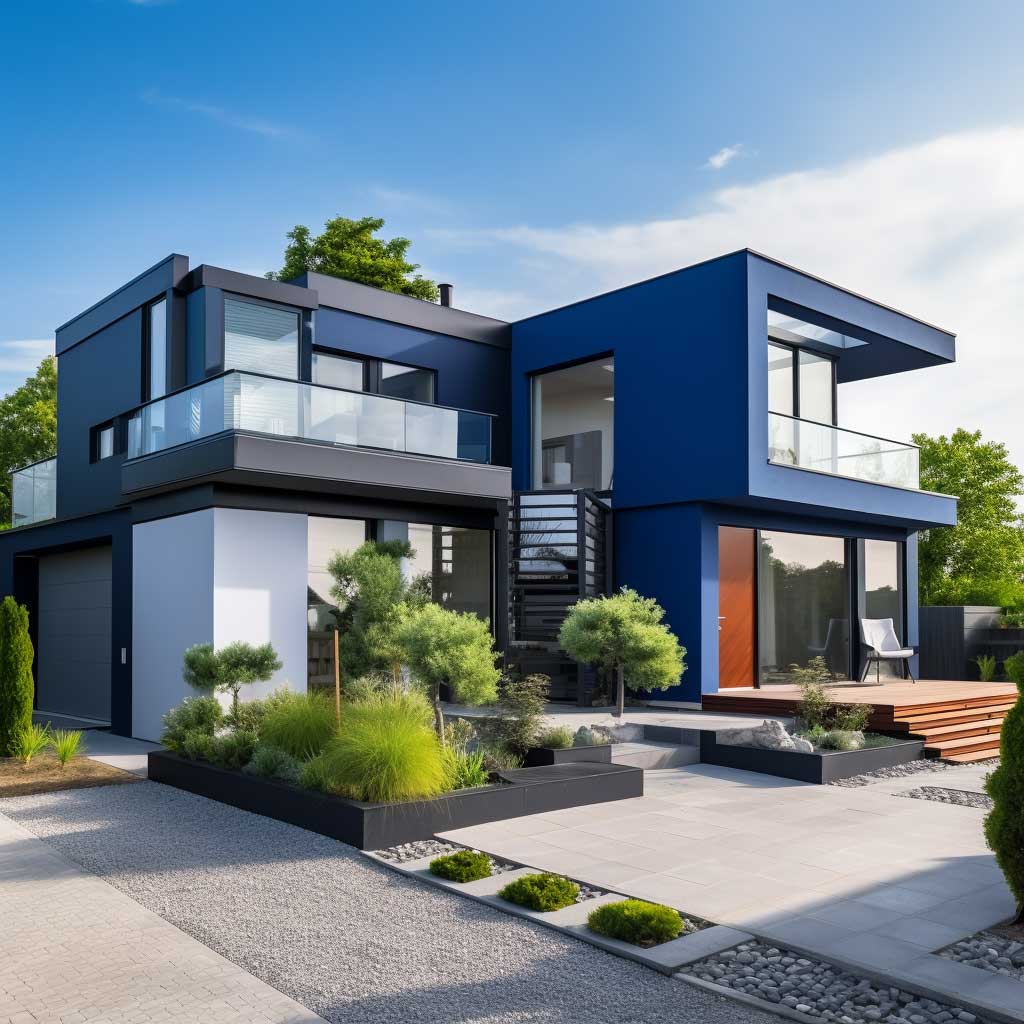



When choosing a bold blue color scheme for your home’s exterior, there are a few things to consider. First, consider the architecture of your home. Certain architectural styles, such as Modern or Coastal, lend themselves well to a bold blue color scheme. The clean lines and simple forms of these styles are complemented by the bold and dynamic nature of blue.
Next, consider your home’s surroundings. If your home is located near the water, a bold blue color scheme can create a connection between your home and its surroundings. On the other hand, if your home is located in a more urban setting, a bold blue color scheme can create a sense of calm and tranquility amidst the hustle and bustle.
Another important consideration when choosing a bold blue color scheme is the amount of sunlight your home receives. Blue tends to look best in natural light, so if your home receives a lot of sunlight, a bold blue color scheme may be a good choice. However, if your home is in a shaded area or does not receive a lot of natural light, you may want to consider a different color scheme.
When it comes to choosing the specific colors for your bold blue color scheme, there are a few options to consider. One option is to choose a monochromatic color scheme, which uses varying shades of the same color. For example, you could choose a light blue for the main color of your home, a darker blue for the trim, and a navy blue for the accents. This creates a cohesive and harmonious look.
Another option is to choose a complementary color scheme, which uses colors that are opposite each other on the color wheel. For example, you could choose a bright blue for the main color of your home, a white or light gray for the trim, and a dark gray or black for the accents. This creates a balanced and harmonious look.
Finally, consider the finish of the paint. A flat or matte finish will give your home a more understated and sophisticated look, while a glossy finish will add a touch of shine and glamour.
In summary, bold blues are a versatile and dynamic choice for exterior house color schemes. They create a striking and modern aesthetic and can be easily complemented with other colors and materials. When choosing a bold blue color scheme for your home’s exterior, consider your home’s architecture, surroundings, and the amount of sunlight it receives. Additionally, consider whether a monochromatic or complementary color scheme will work best for your home, and choose the finish of the paint accordingly.
Classic Whites for a Timeless Look
White has always been a popular choice for exterior house color schemes, and for good reason. White is timeless, classic, and versatile. It works well with a variety of architectural styles and can be easily complemented with other colors and materials. A classic white exterior house color scheme creates a clean and elegant aesthetic that will never go out of style.
White is often associated with purity, cleanliness, and simplicity. It creates a sense of space and openness, making it a great choice for smaller homes or homes with a compact design. Additionally, white reflects light, which can help to keep your home cool in the summer months.
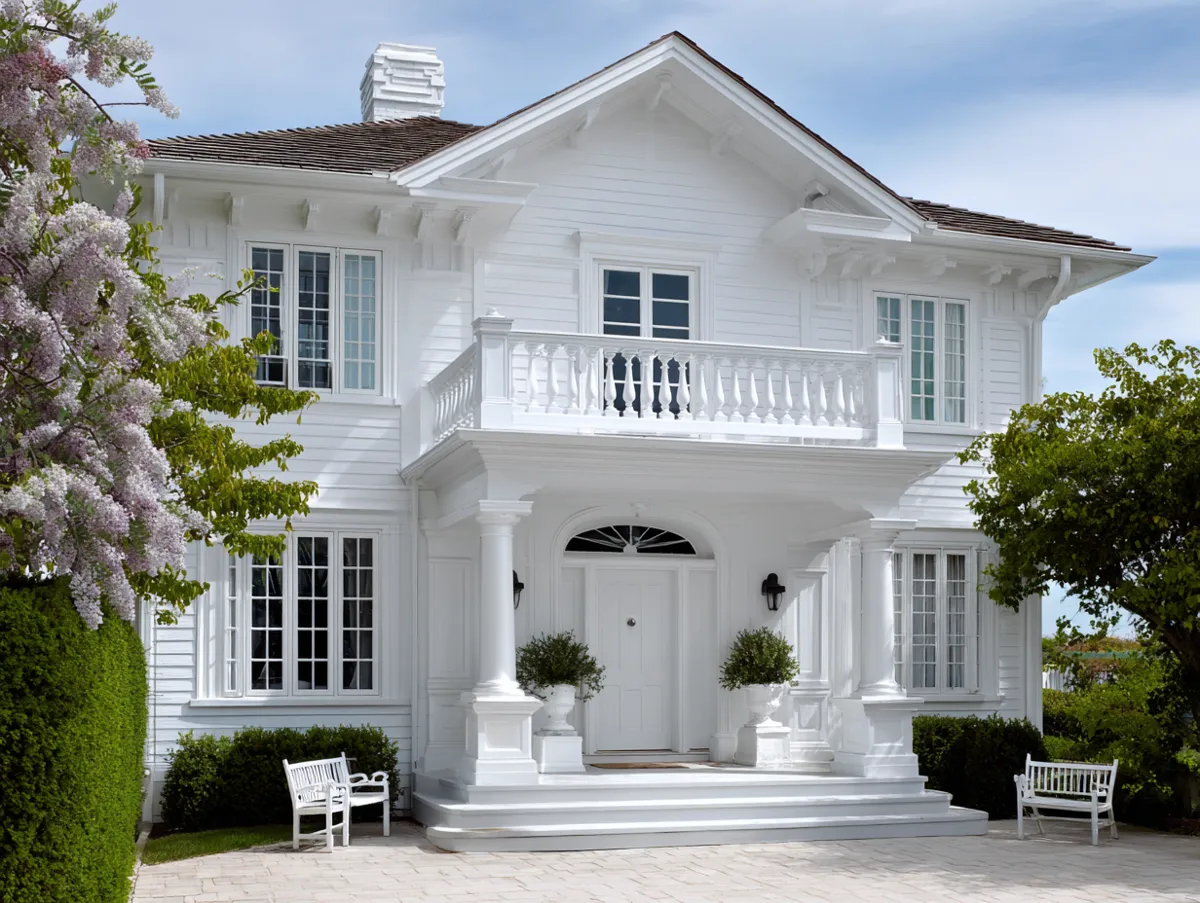









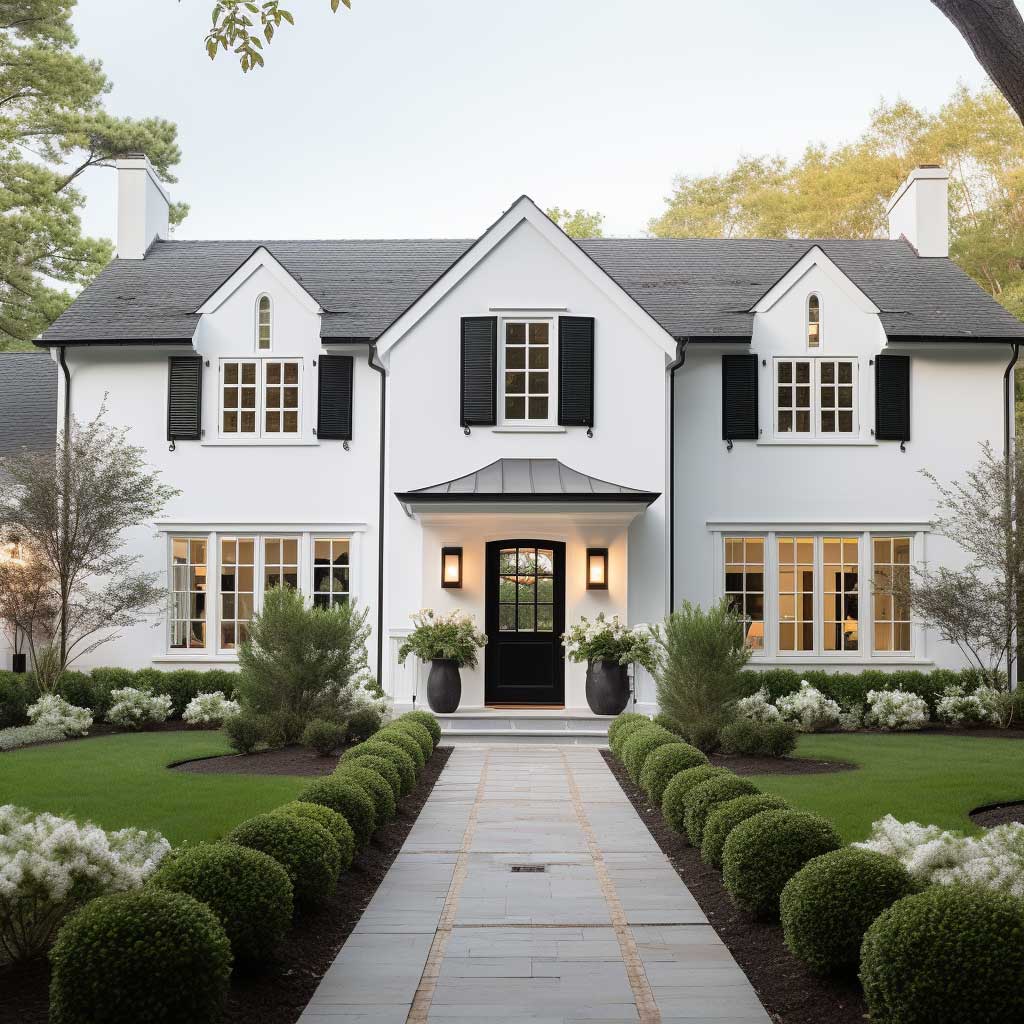

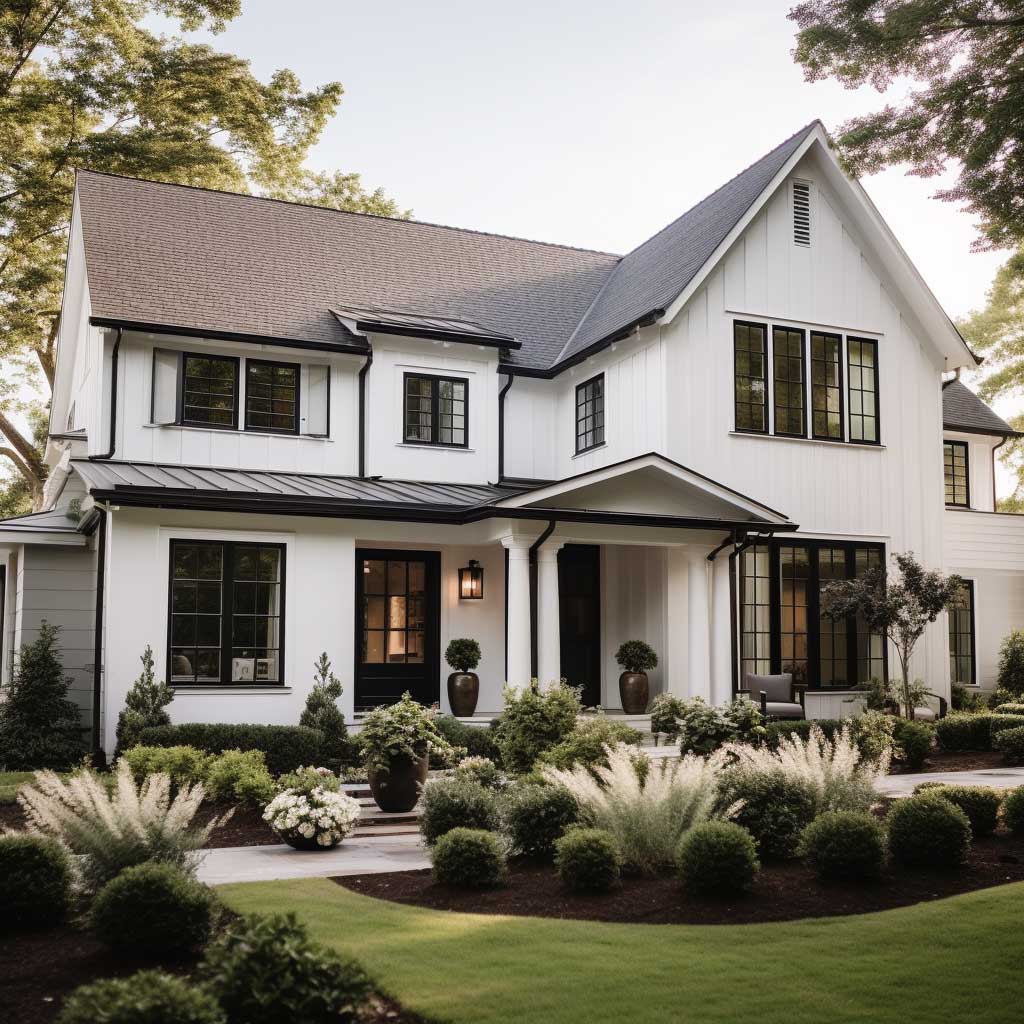

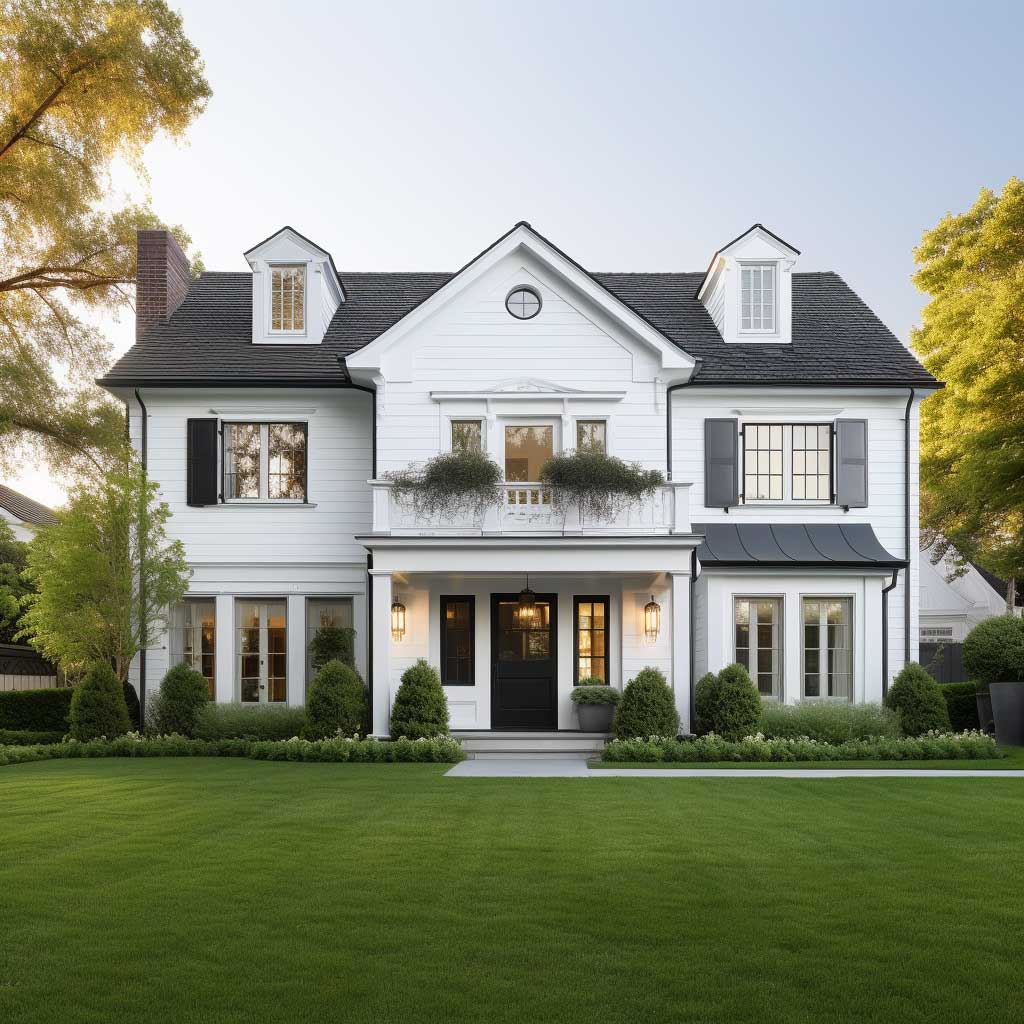

When choosing a classic white color scheme for your home’s exterior, there are a few things to consider. First, consider the architecture of your home. Certain architectural styles, such as Colonial or Georgian, lend themselves well to a classic white color scheme. The detailed craftsmanship and symmetrical design of these styles are complemented by the clean and simple aesthetic of white.
Next, consider your home’s surroundings. If your home is set in a natural landscape with lots of trees and greenery, a classic white color scheme can create a striking contrast and make your home stand out. On the other hand, if your home is in an urban setting with lots of man-made materials, a classic white color scheme can create a sense of calm and tranquility amidst the hustle and bustle.
Another important consideration when choosing a classic white color scheme is the amount of sunlight your home receives. White tends to look best in natural light, so if your home receives a lot of sunlight, a classic white color scheme may be a good choice. However, if your home is in a shaded area or does not receive a lot of natural light, you may want to consider a different color scheme.
When it comes to choosing the specific colors for your classic white color scheme, there are a few options to consider. One option is to choose a monochromatic color scheme, which uses varying shades of the same color. For example, you could choose a bright white for the main color of your home, a soft white for the trim, and an off-white for the accents. This creates a cohesive and harmonious look.
Another option is to choose a complementary color scheme, which uses colors that are opposite each other on the color wheel. For example, you could choose a bright white for the main color of your home, a dark gray or black for the trim, and a light gray for the accents. This creates a balanced and harmonious look.
Finally, consider the finish of the paint. A flat or matte finish will give your home a more understated and sophisticated look, while a glossy finish will add a touch of shine and glamour.
In summary, classic whites are a timeless and versatile choice for exterior house color schemes. They create a clean and elegant aesthetic and can be easily complemented with other colors and materials. When choosing a classic white color scheme for your home’s exterior, consider your home’s architecture, surroundings, and the amount of sunlight it receives. Additionally, consider whether a monochromatic or complementary color scheme will work best for your home, and choose the finish of the paint accordingly.
Earthy Greens for a Natural Feel
Green is a color that is often associated with nature, tranquility, and harmony. It is a color that is soothing to the eyes and can create a sense of calm and relaxation. Earthy greens, such as olive, sage, and moss, are muted and subdued shades of green that can create a natural and harmonious exterior house color scheme.
Earthy greens are versatile and can be adapted to suit a variety of architectural styles and settings. They work well with natural materials, such as stone or wood, and can be easily complemented with other colors and materials. Additionally, earthy greens blend seamlessly with the natural surroundings, creating a harmonious and balanced look.










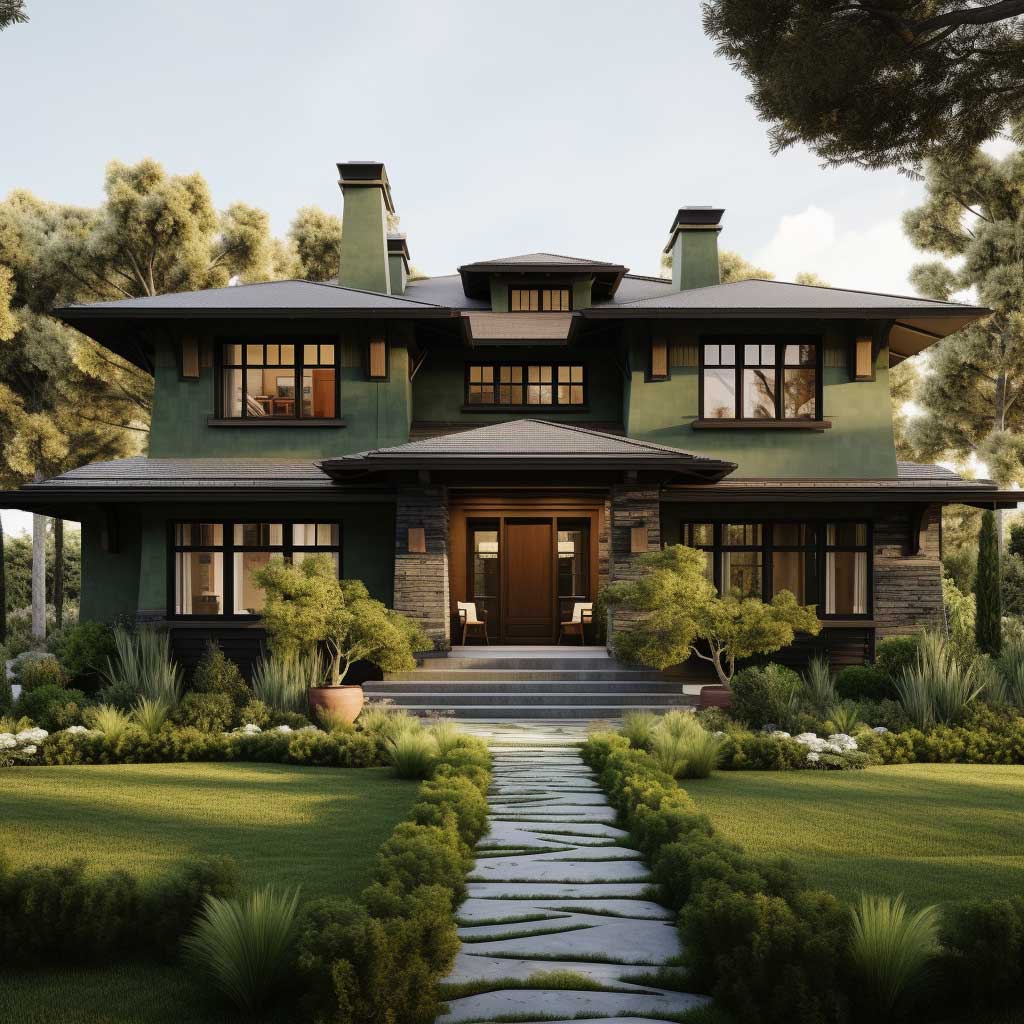

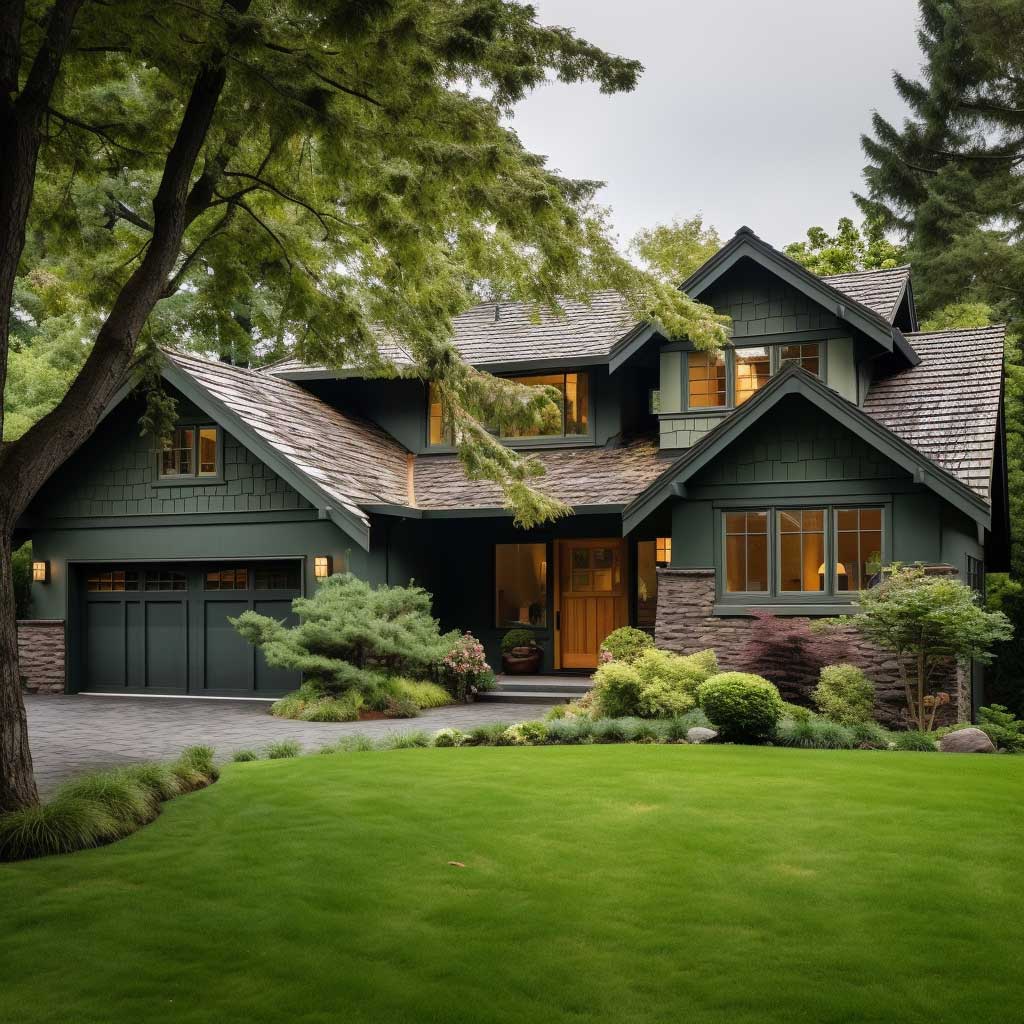



When choosing an earthy green color scheme for your home’s exterior, there are a few things to consider. First, consider the architecture of your home. Certain architectural styles, such as Craftsman or Rustic, lend themselves well to an earthy green color scheme. The natural materials and detailed craftsmanship of these styles are complemented by the natural and harmonious aesthetic of earthy greens.
Next, consider your home’s surroundings. If your home is set in a natural landscape with lots of trees and greenery, an earthy green color scheme can help your home blend seamlessly with its surroundings. On the other hand, if your home is in an urban setting with lots of man-made materials, an earthy green color scheme can create a sense of calm and tranquility amidst the hustle and bustle.
Another important consideration when choosing an earthy green color scheme is the amount of sunlight your home receives. Earthy greens tend to look best in natural light, so if your home receives a lot of sunlight, an earthy green color scheme may be a good choice. However, if your home is in a shaded area or does not receive a lot of natural light, you may want to consider a different color scheme.
When it comes to choosing the specific colors for your earthy green color scheme, there are a few options to consider. One option is to choose a monochromatic color scheme, which uses varying shades of the same color. For example, you could choose a light sage green for the main color of your home, a darker olive green for the trim, and a moss green for the accents. This creates a cohesive and harmonious look.
Another option is to choose a complementary color scheme, which uses colors that are opposite each other on the color wheel. For example, you could choose an olive green for the main color of your home, a light brown or beige for the trim, and a dark brown for the accents. This creates a balanced and harmonious look.
Finally, consider the finish of the paint. A flat or matte finish will give your home a more understated and sophisticated look, while a glossy finish will add a touch of shine and glamour.
In summary, earthy greens are a versatile and harmonious choice for exterior house color schemes. They create a natural and balanced aesthetic and can be easily complemented with other colors and materials. When choosing an earthy green color scheme for your home’s exterior, consider your home’s architecture, surroundings, and the amount of sunlight it receives. Additionally, consider whether a monochromatic or complementary color scheme will work best for your home, and choose the finish of the paint accordingly.
Vibrant Yellows for a Cheerful Appearance
Yellow is a color that is often associated with happiness, energy, and warmth. It is a color that can instantly brighten up any space and create a cheerful and lively vibe. Vibrant yellows, such as lemon, mustard, and sunflower, are bold and dynamic shades of yellow that can create a striking and energetic exterior house color scheme.
Vibrant yellows are versatile and can be adapted to suit a variety of architectural styles and settings. They work well with a variety of other colors and materials and can be easily complemented with other colors and materials. Additionally, vibrant yellows create a striking contrast with the natural surroundings, creating a dynamic and energetic look.














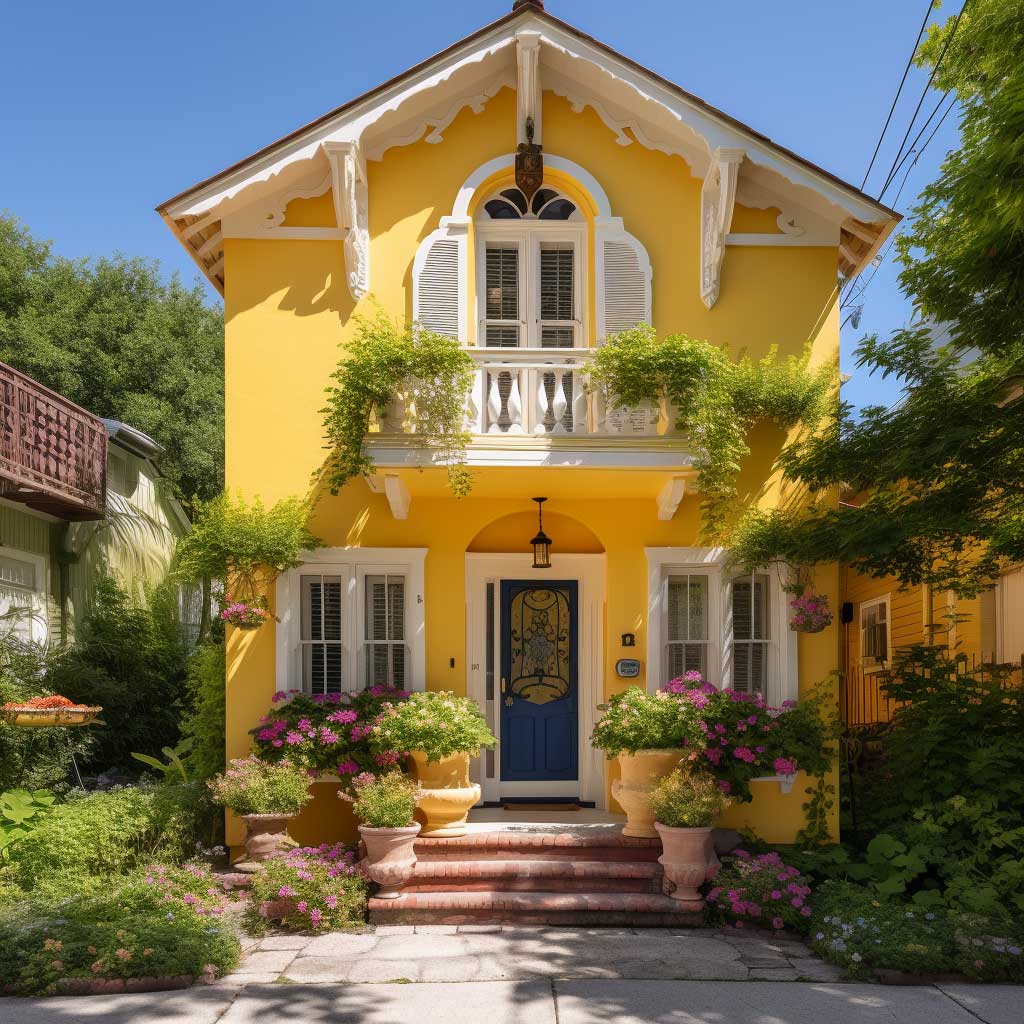

When choosing a vibrant yellow color scheme for your home’s exterior, there are a few things to consider. First, consider the architecture of your home. Certain architectural styles, such as Victorian or Cottage, lend themselves well to a vibrant yellow color scheme. The detailed craftsmanship and ornate design of these styles are complemented by the bold and dynamic aesthetic of vibrant yellows.
Next, consider your home’s surroundings. If your home is set in a natural landscape with lots of trees and greenery, a vibrant yellow color scheme can create a striking contrast and make your home stand out. On the other hand, if your home is in an urban setting with lots of man-made materials, a vibrant yellow color scheme can create a sense of energy and vitality amidst the hustle and bustle.
Another important consideration when choosing a vibrant yellow color scheme is the amount of sunlight your home receives. Vibrant yellows tend to look best in natural light, so if your home receives a lot of sunlight, a vibrant yellow color scheme may be a good choice. However, if your home is in a shaded area or does not receive a lot of natural light, you may want to consider a different color scheme.
When it comes to choosing the specific colors for your vibrant yellow color scheme, there are a few options to consider. One option is to choose a monochromatic color scheme, which uses varying shades of the same color. For example, you could choose a light lemon yellow for the main color of your home, a darker mustard yellow for the trim, and a sunflower yellow for the accents. This creates a cohesive and harmonious look.
Another option is to choose a complementary color scheme, which uses colors that are opposite each other on the color wheel. For example, you could choose a bright sunflower yellow for the main color of your home, a dark blue or navy for the trim, and a light blue for the accents. This creates a balanced and harmonious look.
Finally, consider the finish of the paint. A flat or matte finish will give your home a more understated and sophisticated look, while a glossy finish will add a touch of shine and glamour.
In summary, vibrant yellows are a bold and dynamic choice for exterior house color schemes. They create a cheerful and energetic aesthetic and can be easily complemented with other colors and materials. When choosing a vibrant yellow color scheme for your home’s exterior, consider your home’s architecture, surroundings, and the amount of sunlight it receives. Additionally, consider whether a monochromatic or complementary color scheme will work best for your home, and choose the finish of the paint accordingly.
FAQ
How can I use warm neutrals to create a cozy exterior without my home looking too plain?
To prevent warm neutrals like beige or tan from looking flat, incorporate a variety of textures and accent colors. Pair neutral siding with natural materials like stone or dark wood to add depth, or use a bold, high-contrast color like navy blue or forest green for the front door and shutters. Additionally, choosing a monochromatic palette—where you use varying shades of the same neutral for the main body, trim, and accents—creates a sophisticated and harmonious look that feels intentionally designed rather than just simple.
What are the best architectural styles for a bold blue exterior, and how should I choose the right shade?
Bold blues are particularly effective for Modern or Coastal architectural styles, where the clean lines and proximity to water create a natural setting for vibrant colors. For a contemporary feel, a deep navy or a moody slate blue provides a striking, grounded look, while a bright turquoise can add energy to a coastal cottage. To maintain balance, consider a complementary scheme with white or light gray trim, which creates a crisp, professional finish that highlights the home's structure without being overwhelming.
Is a classic white exterior always the best choice for improving a home's perceived value?
While classic white is a timeless choice that appeals to many buyers because of its clean and elegant aesthetic, its effectiveness depends on the home's architecture and surroundings. It is especially flattering for symmetrical styles like Georgian or Colonial, where the white highlights detailed craftsmanship. However, if your home is in a very shady area, white can sometimes appear dull or greyish; it performs best in bright natural light, which allows it to reflect the sun and keep the home looking open, spacious, and cool.
